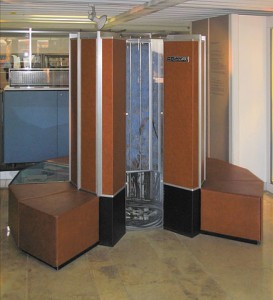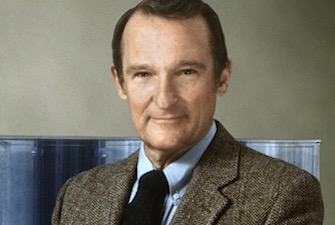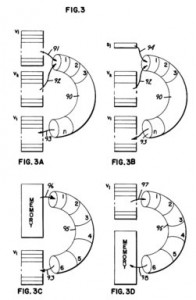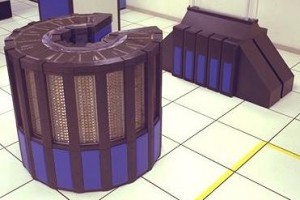Some of the world’s most challenging algorithms can be worked out in mere moments by supercomputers, a type of computing technology which goes well beyond the processing power found in a typical desktop PC. A typical desktop PC has only has one processor even when that processor is a multi-core option capable of running more than one task, and simply cannot touch the computing power of a supercomputer.
Supercomputers today are constructed with tens of thousands of central processing units (CPUs) installed in parallel and in communication with thousands of gigabytes worth of random access memory (RAM), carrying an incredible amount of processing power capable of creating real-time weather models, decrypting data transferred over secure channels or performing genetic analysis. It seems almost like they have been around forever, and for many of us they have been around forever if by forever you mean for our entire life. But computers in general, and supercomputers specifically, have only been around for a couple generations.
If you are a computer aficionado you undoubtedly know the name Seymour Cray. Cray became practically synonymous with supercomputing for decades, in fact Cray is widely known as the father of supercomputing.
Today we take a moment to remember Cray on an important patent anniversary. It was on December 5, 1978 that the United States Patent and Trademark Office issued U.S. Patent No. 4,128,880, entitled Computer Register Vector Processing, which listed Cray as the sole inventor. It was the ‘880 patent for which Cray was posthumously inducted into the National Inventors Hall of Fame in 1997.
Supercomputers
Supercomputers are designed to be so fast that their processing speed is measured on a different order of magnitude entirely than PCs. Processing speed, also known as clock speed, typically tops out at the order of gigahertz, a measure of oscillation indicating a billion pulses per second. A CPU can perform about one instruction per pulse. Instead of hertz, however, processing speed in supercomputers is measured in terms of floating-point operations per second, or flops. As of June 2015, the world’s fastest supercomputer was the Tianhe-2, a Chinese supercomputer developed at the National University of Defense Technology. The Tianhe-2 has 3.12 million processing cores and operates at a processing speed of 33.86 petaflops, allowing it to conduct quadrillions of calculations every second.
Three of the supercomputers in that top 10 list of the most powerful commercially available computers maintained by TOP500, including the second-most powerful supercomputer at the Oak Ridge National Laboratory in Oak Ridge, TN, bear the name of the man known as the father of the supercomputer: Seymour Cray. This December 5th marks the 37th anniversary of the issuance of an important patent in the field of vector processing, a major step forward in supercomputing technology.
Developers of supercomputers have been in pursuit of an infinitely fast clock which is capable of executing a single instruction stream program on a single memory which is both infinitely large and incredibly fast. The creation of supercomputers goes back in large part to the development of the FORTRAN computing language by American computer scientist John Backus, who was working at the time for IBM. FORTRAN became the world’s first high-level programming language that could be widely used among various types of computer architectures, as opposed to the assembly languages of previous years, which was always specific to the particular architecture on which it was intended to run.
Although the Cray-1 was revolutionary in the supercomputing world for many reasons, it was by no means the first computer developed to handle incredibly complex scientific models. By the early 1960s, supercomputers had been developed by IBM (the Stretch), England’s University of Manchester in collaboration with Ferranti Ltd. (the Atlas) as well as Remington Rand (the Univac LARC). These and later models would prove to be incredibly expensive, thus relying a great deal on government funding and a handful of worldwide scientific and engineering institutions.
Seymour Cray
 The name of Seymour Cray, however, would go on to take the leading position from these rivals and become synonymous with the entire industry of supercomputing for decades. From a young age, Cray, a native of Chippewa Falls, WI, always showed an interest in electrical engineering from a young age and when he joined the U.S. Army and arrived in Europe the day after D-Day, he served in an infantry communications platoon. After returning home and earning a bachelor’s in electrical engineering and a master’s in applied mathematics, Cray would begin working on computer development as an employee with Engineering Research Associates, based in St. Paul, MN.
The name of Seymour Cray, however, would go on to take the leading position from these rivals and become synonymous with the entire industry of supercomputing for decades. From a young age, Cray, a native of Chippewa Falls, WI, always showed an interest in electrical engineering from a young age and when he joined the U.S. Army and arrived in Europe the day after D-Day, he served in an infantry communications platoon. After returning home and earning a bachelor’s in electrical engineering and a master’s in applied mathematics, Cray would begin working on computer development as an employee with Engineering Research Associates, based in St. Paul, MN.
It wouldn’t be until 1957, when Cray helped with the founding of the Control Data Corporation (CDC), that his developments in supercomputing would begin to truly take flight. In October 1959, his company released the CDC 1604, the world’s fastest computer at the time and the first fully transistorized computer that worked without vacuum tubes. Cray was the primary engineer on the CDC 1604. A few years later in 1964, Cray outdid himself with his design of the CDC 6600, a machine with the world’s fastest clock time of 100 nanoseconds. It sold for around $7 million when it was first released and is cited by many as the world’s first true supercomputer. Other firsts established by the CDC 6600 include the use of Freon as a cooling agent to keep electronic equipment from overheating and to reduce data transmission times further; the CDC 6600 was also the first computer to utilize a cathode ray tube monitor, establishing the screen display which is now a major component for all human-computer interactions.
Although Cray found engineering success at CDC, he would clash at times with management and eventually requested that a CDC engineering facility be built in his hometown of Chippewa Falls, where he could work without the growing corporate distractions. The next major steps towards more powerful supercomputing technology would be undertaken by Cray at a new business venture that he founded, Cray Research. It was at his own company that he would develop the Cray-1, a marvel of computer engineering and aesthetic design that greatly outdid his previous designs for CDC. This model replaced transistors with integrated circuits and took advantage of the innovative concept of vector processing.
Vector Processing
The ‘880 patent claimed a vector processing apparatus for a computer having a main memory, the apparatus having a plurality of vector registers capable of holding a plurality of elements in an ordered set of data, an arithmetic or logical function unit with a segmented means for holding data for incomplete operations and having an input for receiving operands and an output for delivering results, a path select means associated with the vector registers and responsive to program instructions for selectively connecting individual vector registers for data transmission, and then a control means associated with the vector registers and operative to transmit elements of the ordered set of data from a vector register to a functional unit on successive clock periods. The innovation addressed shortcomings with conventional vector processing machines of the day, enabling the efficient processing of short, moderate and long length vectors.
Vector processing made the Cray-1 supercomputer, which Cray said he designed himself without the use of computer-aided design software but rather with #3 pencils on a quadrille pad, the gold standard of its industry for decades. In vector processing, computers implement an instruction set that operated on one-dimensional data arrays, greatly improving workload performance over the scalar processing techniques used at that time. The use of integrated circuits enabled the Cray 1 to perform 64-bit processing, reaching performance speeds of 136 megaflops. This was, by contrast, much greater than the 3 megaflop performance produced by the CDC 6600.
Commercial Success
The Cray-1 wasn’t simply an ultra-powerful piece of computing equipment; it was also a model of elegant design in computer development where appealing design elements actually served functional purposes. An overhead view of the supercomputer shows that the entire computer is shaped like the letter C, which simply sounds like a smart piece of branding until it’s realized that the curved shape allowed speed-dependent modules to be installed closer to the middle with shorter wire lengths, enabling the entire unit to achieve 80 megahertz of processing speed. A cushioned bench surrounding the computer earned the machine, which retailed for $8.8 million when released in 1977, the nickname of “the world’s most expensive loveseat.” Under the cushions rested the supercomputer’s power supply and air conditioning units and the cushions served the purpose of making maintenance technicians more comfortable when servicing the machine.
After the commercial success of the Cray-1 supercomputer, Seymour Cray continued to pursue improvements in the field over the course of the next two decades. In 1985, Cray Research released the Cray-2 supercomputer which utilized up to 8 CPUs and utilized logic devices packed so tightly that the specially formulated electronic cooling liquid Fluorinert was required to keep the components from overheating. The Cray-2 offered calculation speeds of up to 1.9 gigaflops, making it the first supercomputer to break the gigaflop threshold. Seymour would also pursue the development of a Cray-2 successor that would be known as the Cray-3, but it did not achieve the commercial success of earlier Cray models.
Legacy
Seymour Cray would continue his pursuit of ultra-high speed supercomputing technologies until his death in October 1996. Tragically, Cray lost his life as a result of injuries sustained in a car crash. Cray’s legacy in the computing world, however, continues to be legendary, as is evidenced by the fact that so many Cray designs still top the list of the world’s most powerful supercomputers. In 1997, the Institute of Electrical and Electronic Engineers (IEEE) established the Seymour Cray Computer Engineering Award to recognize innovative contributions to high-performance computing which reflects the creative spirit that made Cray a mastermind of the supercomputing world.

![[IPWatchdog Logo]](https://ipwatchdog.com/wp-content/themes/IPWatchdog%20-%202023/assets/images/temp/logo-small@2x.png)






![[Advertisement]](https://ipwatchdog.com/wp-content/uploads/2024/04/Artificial-Intelligence-2024-REPLAY-sidebar-700x500-corrected.jpg)
![[Advertisement]](https://ipwatchdog.com/wp-content/uploads/2024/04/UnitedLex-May-2-2024-sidebar-700x500-1.jpg)
![[Advertisement]](https://ipwatchdog.com/wp-content/uploads/2024/04/Patent-Litigation-Masters-2024-sidebar-700x500-1.jpg)

![[Advertisement]](https://ipwatchdog.com/wp-content/uploads/2021/12/WEBINAR-336-x-280-px.png)
![[Advertisement]](https://ipwatchdog.com/wp-content/uploads/2021/12/2021-Patent-Practice-on-Demand-recorded-Feb-2021-336-x-280.jpg)
![[Advertisement]](https://ipwatchdog.com/wp-content/uploads/2021/12/Ad-4-The-Invent-Patent-System™.png)






Join the Discussion
No comments yet.